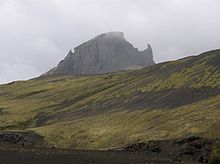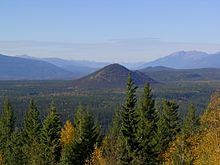Palagonite back



Palagonite ridges and palagonite cones are a type of subglacial volcanoes formed by explosive eruptions under a glacier . The loose masses ( tephra ) that are expelled in the process solidify immediately to form volcanic glass , are converted into palagonite over time by the abundant water and then baked to tuff .
If it is a fissure eruption is, creates an elongated palagonite back when only a single central vent erupts, there is formation of a palagonite cone .
When the volcanic structures grow out of the glacier or water, the lava can also flow out effusively and form layers of lava that are no longer converted into palagonite. The resulting volcanic shape is called tabular volcano or Tuya .
Most of the palagonite ridges were formed during the last or penultimate Ice Age and are mostly ice-free today.
Occurrence
Palagonite ridges occur where there has been large ice cover over volcanic areas in the past, i.e. in Canada, in Antarctica, but especially in Iceland , where they are very common and are also called Moberg ridge .
Examples of palagonite ridges in Iceland are the Einhyrningur and the Helgafell í Mosfellssveit . A particularly uniform Palagonitkegel is the Keilir .
Individual evidence
- ↑ Thor Thordarson, Armann Hoskuldsson: Iceland (Classic Geology in Europe 3). Terra Publishing, Harpenden 2007, ISBN 1-903544-06-8 , page 33.